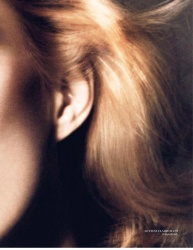David Sims grants a rare interview inside Industrie magazine’s latest issue. Journalist, Murray Healy, speaks with Sims about his early 1990s work with
Melanie Ward, the process Sims takes from concept to execution, and opens up about some issues that exist within the current state of fashion photography. The issue is on newsstands now, but you can read a preview of their conversation below.
Sims on the affect Photoshop has in fashion photography:
“What Photoshop has done is more or less enable people to kind of pastiche those [referential] images to such an extent that that they become somewhat inseparable from one another. So the success or otherwise of a picture is judged by whether people will get the reference, so then they will appreciate the outcome of this more recent revived version of it. So now it’s about ‘yeah I get that reference’; the question is no longer ‘is that original?’ or ‘is it new?’ People appreciate pictures in a different way within the fashion industry now: I think people’s perception is that it should live up to reference, and very often it’s a nod to a pre-existing fashion image.”
Sims on sometimes thinking, “Am I good enough?”:
“I will say that, of all the successful people I can think of, they preserve just a little bit of self-hate. I do think there’s been times when I’ve looked at my work and thought I’m not good enough. It’s not a question I can answer myself: it’s not every day you go to work and create works of genius, you know, you get good days and bad days. I think that’s what… Without harping on about what the young generation are experiencing – because I shouldn’t be speaking for them – I do think their biggest fear is actually, ‘Let’s not **** up.’ And I think our generation was more insouciant, less informed.”
Sims on the current shift happening in fashion photography:
“I think photography is going through a shift in the same way that painting and sketching went through a shift when photography first started to become a relevant medium. The early photographers, a lot them, the pictorialists, tried to make their work look like sketches until the modernists came along and said, ‘Actually, no, photography in itself is the thing, it’s the most beautiful thing in its own right.’ … If you can get on Photoshop then you don’t even have to take a picture – you can steal something from the internet, you can go wherever you want and back again without ever leaving your chair … Any of us can sit at home and take images anywhere. I think there are people who are doing that and making really good work, it’s just that it’s not really appreciated yet; I don’t know when that will find a home in fashion magazines.”
Sims on creating distinctive images:
“If you’re working continually with someone, then you can actually treat your work as almost an entity in itself. I would do a picture with say Joe McKenna that I would never do with, let’s say, Grace Coddington. They all have their own bearing, but I don’t think Joe would do the same picture with me that he does with Bruce, they’re just completely different. And I don’t like a crossover: I hate seeing elements of my work brought into someone else’s set, it feels a bit like a betrayal. I try to think of the pictures that I do with, say, Joe as being particular to him and I, or the picture I took for, to pick a magazine, French Vogue as being particular to that collaboration. And the same with Grace: I’m not about to shop an American Vogue picture to British Vogue. And that’s instinctive for me, it’s not like I’ve made a conscious rule.”




















